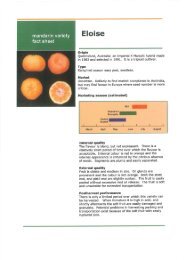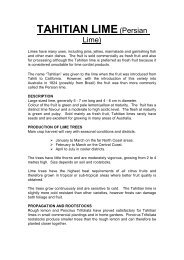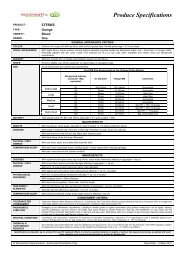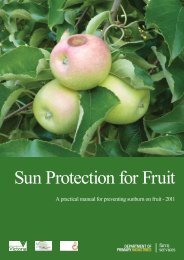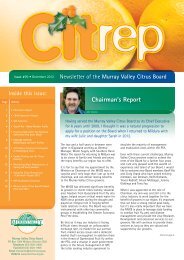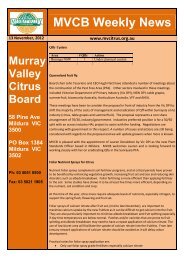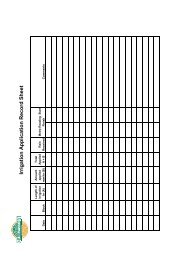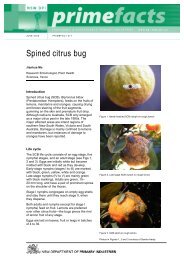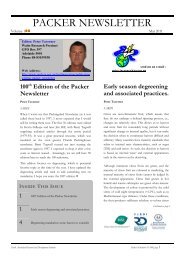Citrus exotic pest and disease survey 2010 Final - Murray Valley ...
Citrus exotic pest and disease survey 2010 Final - Murray Valley ...
Citrus exotic pest and disease survey 2010 Final - Murray Valley ...
Create successful ePaper yourself
Turn your PDF publications into a flip-book with our unique Google optimized e-Paper software.
<strong>Citrus</strong> <strong>exotic</strong> <strong>pest</strong> <strong>and</strong><br />
<strong>disease</strong> <strong>survey</strong> -<strong>2010</strong>
A report for:<br />
PLANT STANDARDS BRANCH, BIOSECURITY VICTORIA<br />
by:<br />
David Madge, BIOSCIENCES RESEARCH DIVISION, DPI VICTORIA<br />
If you would like to receive this information/publication<br />
in an accessible format (such as large print or audio)<br />
please call the Customer Service Centre on 136 186, TTY<br />
1800 122 969, or email<br />
customer.service@dpi.vic.gov.au.<br />
Published by the Department of Primary Industries<br />
Bioprotection Research, October <strong>2010</strong><br />
© The State of Victoria <strong>2010</strong>.<br />
This publication is copyright. No part may be reproduced by any<br />
process except in accordance with the provisions of the Copyright Act<br />
1968.<br />
Authorised by the Department of Primary Industries<br />
1 Spring Street, Melbourne 3000.<br />
Disclaimer<br />
This publication may be of assistance to you but the State of Victoria<br />
<strong>and</strong> its employees do not guarantee that the publication is without<br />
flaw of any kind or is wholly appropriate for your particular purposes<br />
<strong>and</strong> therefore disclaims all liability for any error, loss or other<br />
consequence which may arise from you relying on any information in<br />
this publication.<br />
For more information about DPI go to www.dpi.vic.gov.au<br />
or phone the Customer Service Centre on 136 186.<br />
3
Contents<br />
Definitions 6<br />
Acknowledgements 6<br />
Executive summary 7<br />
Introduction 8<br />
Methods 8<br />
Geographical region to be <strong>survey</strong>ed 8<br />
Selection of properties <strong>and</strong> citrus<br />
patches for inspection 8<br />
Survey procedure 9<br />
Sample analysis 9<br />
Resources 9<br />
Survey officers 9<br />
Pests <strong>and</strong> <strong>disease</strong>s targeted 9<br />
Statistical analysis 13<br />
Pest <strong>and</strong> <strong>disease</strong> observations 14<br />
Results 14<br />
Location <strong>and</strong> characteristics of<br />
inspected citrus patches 14<br />
Statistical analysis 17<br />
Industry liaison 18<br />
Discussion 18<br />
Conclusions 19<br />
Recommendations 20<br />
References 20<br />
4
Appendix 1 Field <strong>survey</strong> procedure 21<br />
Appendix 2 Sample collection, h<strong>and</strong>ling<br />
<strong>and</strong> transport 24<br />
Appendix 3 Full decontamination<br />
procedure 26<br />
Appendix 4 Equipment lists 27<br />
Appendix 5: Field Survey Sheet 29<br />
Appendix 6: Survey site data 31<br />
Appendix 7: Survey site location <strong>and</strong><br />
contact details (see separate<br />
confidential supplement) 34<br />
5
Definitions<br />
BV Biosecurity Victoria<br />
DPI Department of Primary Industries Victoria<br />
MVCB <strong>Murray</strong> <strong>Valley</strong> <strong>Citrus</strong> Board<br />
CTV <strong>Citrus</strong> Tristeza Virus<br />
<strong>Citrus</strong> patch An area of citrus trees of the same variety, rootstock <strong>and</strong> age<br />
<strong>Citrus</strong> block or property A property that includes one or more citrus patches but that may also<br />
6<br />
carry other crop types<br />
Acknowledgements<br />
The author gratefully acknowledges the following for their assistance <strong>and</strong> cooperation during the<br />
planning <strong>and</strong> execution of this <strong>survey</strong>:<br />
Craig Murdoch (BV) for guidance <strong>and</strong> feedback as Survey Coordinator<br />
Martin Mebalds (BV) for resources such as GPS units, <strong>and</strong> statistical analysis for the <strong>survey</strong><br />
Mary Cannard (<strong>Murray</strong> <strong>Valley</strong> <strong>Citrus</strong> Board, Mildura) for her considerable <strong>and</strong> invaluable input<br />
into the selection of potential <strong>survey</strong> properties, contact with citrus growers <strong>and</strong> provision of<br />
property maps <strong>and</strong> planting data<br />
Tony Bothroyd (<strong>Murray</strong> <strong>Valley</strong> <strong>Citrus</strong> Board, Mildura) for sharing his valuable local knowledge of<br />
the citrus industry to assist in the location <strong>and</strong> selection of <strong>survey</strong> properties<br />
Frann Sette (SunRise 21 Inc, Mildura) for production of a regional map of citrus property<br />
locations<br />
<strong>Citrus</strong> growers across the region for their cooperation <strong>and</strong> willingness to be involved in the<br />
<strong>survey</strong>
Executive summary<br />
<strong>Citrus</strong> trees on 40 properties in the <strong>Murray</strong> <strong>Valley</strong> growing districts of Victoria, from Kerang to the<br />
South Australian border, were <strong>survey</strong>ed between June <strong>and</strong> August <strong>2010</strong> for a range of <strong>exotic</strong><br />
<strong>disease</strong>s <strong>and</strong> <strong>pest</strong>s as part of an ongoing surveillance program. A high degree of cooperation from<br />
the industry <strong>and</strong> assistance from the <strong>Murray</strong> <strong>Valley</strong> <strong>Citrus</strong> Board ensured the successful operation<br />
of the <strong>survey</strong>. Survey <strong>and</strong> hygiene procedures followed during the <strong>survey</strong> were adapted from<br />
protocols developed during previous surveillance activities for citrus canker <strong>and</strong> other <strong>exotic</strong> <strong>pest</strong>s<br />
<strong>and</strong> <strong>disease</strong>s of concern.<br />
The field <strong>survey</strong> <strong>and</strong> subsequent laboratory testing of leaf samples did not detect any of the target<br />
<strong>disease</strong>s <strong>and</strong> <strong>pest</strong>s, namely: citrus canker (Xanthomonas citri subsp. citri), bacterial spot<br />
(Xanthomonas axonopodis pv citrumelo), mel secco (Phoma tracheiphila), citrus scab (Elsinoe<br />
fawcetti), sweet citrus scab (Elsinoe australis), citrus black spot (Guignardia citricarpa), citrus<br />
stubborn (Spiroplasma citri), citrus tristeza closterovirus ( CTV), citrus greening/ Huanglongbing<br />
(C<strong>and</strong>idatus Liberibacter sp.), powdery mildew (Oidium tingitaninum), cercospora spot<br />
(Phaeoramularia angolensis), Satsuma dwarf virus, citrus snow scale/white louse scale (Unaspis<br />
citri), citrus red mite (Panonychys citri), glassy-winged sharp shooter (Homalodisca vitripennis),<br />
spiralling whitefly (Aleurodicus dispersus) <strong>and</strong> purple round scale/Florida red scale<br />
(Chrysomphalus aonidum).<br />
Statistical analysis of accumulative surveillance results yielded estimates of the probability of<br />
Victoria being free from these <strong>exotic</strong> <strong>disease</strong>s <strong>and</strong> <strong>pest</strong>s to be 99.7% for citrus canker <strong>and</strong> 98.2%<br />
for the other targeted organisms.<br />
<strong>Citrus</strong> tristeza closterovirus was detected in samples from 34 of the forty inspected sites, but<br />
whether any severe CTV strains were present could not be determined with the available tests.<br />
7
Introduction<br />
Under a Commonwealth Government biosecurity program, Australian farming industries are<br />
periodically <strong>survey</strong>ed for the presence of <strong>exotic</strong> <strong>pest</strong>s <strong>and</strong> <strong>disease</strong>s. The <strong>survey</strong>s, performed with<br />
industry support, are intended to reassure our trading partners that certain plant <strong>pest</strong>s <strong>and</strong><br />
<strong>disease</strong>s are absent from our farms.<br />
Victorian citrus properties were <strong>survey</strong>ed in 2004 for citrus canker <strong>and</strong> in 2006 for a broader<br />
range of <strong>exotic</strong> <strong>pest</strong>s <strong>and</strong> <strong>disease</strong>s. As part of this ongoing surveillance program, Biosecurity<br />
Victoria (BV) commissioned DPI Victoria to undertake a <strong>survey</strong> for <strong>exotic</strong> <strong>pest</strong>s <strong>and</strong> <strong>disease</strong>s on<br />
citrus properties in the <strong>Murray</strong> <strong>Valley</strong> region of Victoria. The <strong>survey</strong> was to include approximately<br />
40 sites <strong>and</strong> provide a broad geographical cover of the citrus districts within the region.<br />
Methods<br />
Geographical region to be <strong>survey</strong>ed<br />
<strong>Citrus</strong> properties to be <strong>survey</strong>ed were to be located in the <strong>Murray</strong> <strong>Valley</strong>, on the Victorian side of<br />
the <strong>Murray</strong> River between Koondrook in the east <strong>and</strong> the South Australian border in the west.<br />
Selection of properties <strong>and</strong> citrus patches for inspection<br />
To ensure the <strong>survey</strong> provided a good cover of the region, Sunrise21 Inc was contracted to<br />
produce a map of all citrus property locations in the region, based on <strong>2010</strong> data. The map was<br />
used to highlight potential <strong>survey</strong> sites at a district level. This information was then used by the<br />
Survey Officer <strong>and</strong> <strong>Murray</strong> <strong>Valley</strong> <strong>Citrus</strong> Board (MVCB) to select specific properties to be contacted.<br />
The targeted selection of properties ensured that the <strong>survey</strong> included:<br />
8<br />
small <strong>and</strong> large properties<br />
family <strong>and</strong> corporate properties<br />
organic <strong>and</strong> conventional properties<br />
When growers agreed to have their citrus inspected, the MVCB provided the Survey Officer with<br />
each grower’s contact details, property map <strong>and</strong> planting data. The Survey Officer then contacted<br />
each grower directly to arrange a suitable time to visit the property. The Survey Officer also used<br />
the planting data to select specific citrus patches for inspection. The aim was to include, as far as<br />
possible, a broad range of varieties, rootstocks <strong>and</strong> tree ages, with the inspected patches<br />
providing a good representation of the industry as a whole. Inspection of a broad range of<br />
varieties was also necessary to enhance the chance of detection of <strong>pest</strong> <strong>and</strong> <strong>disease</strong> symptoms, as<br />
the target <strong>pest</strong> organisms exhibit different preferences for citrus varieties.
Survey procedure<br />
Based on the experience from past citrus <strong>survey</strong>s in the <strong>Murray</strong> <strong>Valley</strong>, this <strong>survey</strong> was conducted<br />
with the assumption that <strong>exotic</strong> <strong>pest</strong>s <strong>and</strong> <strong>disease</strong>s were not present in the region. Preparations<br />
were however in place to allow for the necessary hygiene <strong>and</strong> decontamination procedures to be<br />
implemented immediately on-site in the event that a suspect <strong>exotic</strong> <strong>pest</strong> or <strong>disease</strong> was<br />
encountered.<br />
The actual procedures followed during the <strong>survey</strong> were adapted from two earlier protocols (see<br />
CAS Biosecurity 2006 <strong>and</strong> Plant St<strong>and</strong>ards Branch 2007) <strong>and</strong> are listed in Appendices 1 to 4. As<br />
detailed in Appendix 1, even though the citrus patches were assumed to be free of <strong>exotic</strong> <strong>pest</strong>s<br />
<strong>and</strong> <strong>disease</strong>s, basic hygiene measures including boot <strong>and</strong> h<strong>and</strong> decontamination were applied<br />
between properties throughout the <strong>survey</strong>.<br />
The form used to record <strong>survey</strong> patch details required under the above procedures is included in<br />
‘Appendix 5: Field Survey Sheet’. This sheet was modified to reflect the terminology used by MVCB<br />
in defining citrus properties <strong>and</strong> patches.<br />
Sample analysis<br />
Leaf samples collected during the <strong>survey</strong> were inspected by DPI Crop Health Services for the<br />
presence of <strong>disease</strong> organisms <strong>and</strong> invertebrate <strong>pest</strong>s. The samples were specifically tested for<br />
<strong>Citrus</strong> Tristeza Virus (CTV) <strong>and</strong> citrus greening <strong>disease</strong> C<strong>and</strong>idatus Liberibacter. Other pathogens<br />
were investigated when visible symptoms indicated a need.<br />
Resources<br />
BV provided DPI with laminated colour photographs of <strong>exotic</strong> citrus <strong>pest</strong> <strong>and</strong> <strong>disease</strong> symptoms for<br />
referral during the <strong>survey</strong>, as well as GPS units <strong>and</strong> sample security seals. Other necessary<br />
materials (see ‘Appendix 4 Equipment lists’) were purchased or provided as needed by the Survey<br />
Officer.<br />
Survey officers<br />
Craig Murdoch (BV Knoxfield) was the Survey Coordinator for this <strong>survey</strong>. David Madge (DPI<br />
Mildura) as the Survey Officer, was responsible for the day to day planning, coordination <strong>and</strong><br />
conduct of the <strong>survey</strong> <strong>and</strong> liaison with SunRise21, the <strong>Murray</strong> <strong>Valley</strong> <strong>Citrus</strong> Board, BV <strong>and</strong> citrus<br />
growers. Mr Madge had 27 years research experience with DPI in the Sunraysia district of the<br />
<strong>Murray</strong> <strong>Valley</strong>, including citrus IPM research <strong>and</strong> extension. He maintained good relations with the<br />
industry organisations <strong>and</strong> numerous citrus growers.<br />
Pests <strong>and</strong> <strong>disease</strong>s targeted<br />
<strong>Citrus</strong> canker, Xanthomonas citri subsp. citri<br />
Varieties affected: Grapefruit > sweet orange <strong>and</strong> lemon > m<strong>and</strong>arin.<br />
<strong>Citrus</strong> canker is caused by the bacterium Xanthomonas axonopodis pv. citri. Other common names<br />
of this <strong>disease</strong> are, bacterial canker of citrus, South American canker, false canker, canker B, citrus<br />
9
acteriosis <strong>and</strong> Asiatic canker. All aboveground parts of susceptible citrus varieties are attacked,<br />
particularly young leaves, branches <strong>and</strong> fruit (Schubert et al., 2001). The <strong>disease</strong> first appears as<br />
small, raised, watery circular spots or lesions on leaves or fruit. The lesions are initially white or<br />
yellow/dark green <strong>and</strong> later become thick, brown <strong>and</strong> corky. As the lesions grow they thicken into<br />
white, spongy scabs which darken <strong>and</strong> become corky before developing crater-like centres<br />
surrounded by a yellow halo. The lesion centres may fall out, creating a short-hole effect The<br />
ultimate size of the lesion depends on the host, on some grapefruit varieties lesions are as large<br />
as 9 mm in diameter.<br />
Similar symptoms appear on twigs <strong>and</strong> fruit, including raised corky lesions surrounded by a water<br />
soaked margin, although twig lesions do not develop a halo. Sunken craters are particularly<br />
distinct on fruit, but the lesion does not penetrate far into the rind. Defoliation, dieback <strong>and</strong> fruit<br />
drop is common as <strong>disease</strong> severity increases (Goto <strong>and</strong> Yaguchi, 1979).<br />
Bacterial spot (nursery leaf spot), Xanthomonas axonopodis pv Citrumelo<br />
Varieties affected: Possibly all citrus<br />
Similar symptoms to canker but lesions may have larger water-soaked margins <strong>and</strong> become less<br />
pustular <strong>and</strong> corky than canker. Possibly only obvious in nursery situations.<br />
Mal secco, Phoma tracheiphila<br />
Varieties affected: Lemon <strong>and</strong> lime > m<strong>and</strong>arin. Rare on grapefruit <strong>and</strong> sweet orange.<br />
Symptoms appear in spring <strong>and</strong> include wilting or drying of leaves, withered shoots or suckers<br />
bearing signs of fungal infection, especially silvery-grey bark that eventually ruptures to show<br />
numerous small black spots (spore bodies). Recently infected woody tissue has a pinkish<br />
coloration <strong>and</strong> the midrib of fallen leaves may have a reddish colour. When this <strong>disease</strong> develops<br />
rapidly, the foliage can dry on the tree.<br />
<strong>Citrus</strong> Scab (lemon or sour orange scab), Elsinoe fawcetti<br />
Varieties affected: Sweet orange <strong>and</strong> lime may be less susceptible.<br />
Trees grafted onto rough lemon rootstock are most susceptible to this fungus. Leaf, stem <strong>and</strong><br />
fruit symptoms appear as light coloured, raised rough corky scabs, <strong>and</strong> leaves may become<br />
distorted. A yellow halo surrounds the leaf scabs on some citrus varieties. Development of the<br />
<strong>disease</strong> is favoured by warm moist conditions.<br />
Sweet citrus scab (sweet orange scab), Elsinoe australis<br />
Varieties affected: Sour orange may be less susceptible.<br />
Affects the fruit <strong>and</strong> leaves <strong>and</strong> rarely the stems. Lesions on fruit <strong>and</strong> leaves are dark in colour,<br />
round, flattened <strong>and</strong> smooth. On younger fruits it causes a deformation of the rind, forming corky,<br />
round/irregular, protuberant lesions 2–6 mm in diameter. Leaf <strong>and</strong> twig lesions are initially<br />
funnel-shaped pockets, later scab-like, smooth <strong>and</strong> glossy, up to 2 mm diameter.<br />
<strong>Citrus</strong> Black Spot, Guignardia citricarpa<br />
Varieties affected: All citrus, particularly lemons.<br />
Infections occur in the first 4-6 months after fruit set but the fungal mycelium is dormant just<br />
under the skin until fruit maturity when black spots appear on the fruit.<br />
10
<strong>Citrus</strong> Stubborn, Spiroplasma citri<br />
Varieties affected: Most citrus. Symptoms milder on lemons <strong>and</strong> limes. Many non-citrus hosts.<br />
Trees affected when young are stunted. Leaves are shorter, broader, often cup shaped <strong>and</strong> more<br />
upright, sometimes mottled or chlorotic. Shoots may be abnormally bunched <strong>and</strong> fruit may be<br />
stunted, lopsided or acorn shaped. Fruit often don’t colour fully at their stem end. This <strong>disease</strong><br />
may reduce yield under hot, dry conditions.<br />
CTV, <strong>Citrus</strong> Tristeza Closterovirus<br />
Varieties affected: All citrus but symptoms worst on lime, grapefruit <strong>and</strong> some sweet orange.<br />
Tree stunting, stem pitting, leaf yellowing <strong>and</strong> cupping, <strong>and</strong> reduced fruit size may be seen. Trees<br />
on sour orange rootstock (C. aurantium) can decline rapidly <strong>and</strong> die because of the death of the<br />
rootstock at the graft union. Mild strains of tristeza which cause symptomless infections are often<br />
used to cross-protect citrus from severe CTV.<br />
<strong>Citrus</strong> greening/ Huanglongbing, C<strong>and</strong>idatus Liberibacter spp.<br />
Varieties affected: All citrus but worst on sweet orange <strong>and</strong> m<strong>and</strong>arin.<br />
Affected shoots are yellowed with asymmetric mottled leaves (mottling across veins); small upright<br />
chlorotic leaves, out of phase flushing <strong>and</strong> branch dieback. Unseasonal <strong>and</strong> heavy flowering may<br />
occur on <strong>disease</strong>d branches. Fruit can be small, lopsided <strong>and</strong> bitter-tasting with small, brown,<br />
aborted seeds <strong>and</strong> uneven colouring at maturity. Excessive fruit drop can occur. Numerous other<br />
<strong>disease</strong>s <strong>and</strong> nutrient deficiencies can result in superficially similar symptoms.<br />
Powdery mildew, Oidium tingitaninum<br />
Varieties affected: All citrus but m<strong>and</strong>arin, tangerine <strong>and</strong> sweet orange are most susceptible.<br />
This <strong>disease</strong> affects leaves, stems <strong>and</strong> fruit <strong>and</strong> is more likely to occur in nurseries. Whitish<br />
powdery patches of mildew form on the upper surface of leaves, which may then shrivel <strong>and</strong> fall.<br />
May cause premature leaf <strong>and</strong> fruit drop <strong>and</strong> dieback. Older damage on leaves <strong>and</strong> fruit turns<br />
brown/grey, with remaining fruit developing brown irregular markings.<br />
Cercospora spot, Phaeoramularia angolensis<br />
Varieties affected: Possibly all citrus.<br />
Fruits <strong>and</strong> leaves are much more susceptible than stems, on which symptoms are rare. Leaves<br />
develop initially greenish-yellow patches. At maturity, leaf spots (mainly on the underside of<br />
leaves) are 4-10 mm or more in diameter, pale-brown to brown (blackish-brown when sporulation<br />
is dense), surrounded by a dark-brown margin <strong>and</strong> a yellow halo. The centre often becomes<br />
detached resulting in a shot-hole effect. Generalised leaf death caused by joining of several<br />
lesions can result in defoliation. During wet weather the lesions sporulate <strong>and</strong> become black.<br />
On young fruits, brown necrotic lesions form, usually circular, slightly sunken, surrounded by a<br />
raised ring giving the fruit a blistered appearance. During wet weather, the lesions sporulate <strong>and</strong><br />
become black. In young fruits, a generalised necrosis sometimes forms, resulting in premature<br />
fruit drop. When infection of stems occurs, the lesions are dark-brown <strong>and</strong> usually occur as<br />
extensions of petiole lesions. They may join resulting in stem die-back or the formation of corky<br />
internodal regions.<br />
11
Satsuma dwarf virus<br />
Varieties affected: Most citrus, but worst on Satsuma m<strong>and</strong>arin.<br />
On Satsuma m<strong>and</strong>arin, affected laves are typically narrower, darker in colour <strong>and</strong> spoon or boat<br />
shaped, <strong>and</strong> infected trees are stunted <strong>and</strong> produce lower yields. Other citrus types may have mild<br />
or absent symptoms.<br />
<strong>Citrus</strong> snow scale/white louse scale, Unaspis citri<br />
Varieties affected: All citrus.<br />
The scales are mussel-shaped, 1.5-2 mm long, dull brown or grey, with grey margins <strong>and</strong> length<br />
wise median ridges. Infestations peak in autumn. Green bark, leaves, twigs <strong>and</strong> fruit are affected.<br />
On leaves, scales gather close to ribs <strong>and</strong> the midribs. Young trees (under 10 years of age) are<br />
more likely to have lighter infestations on the trunk <strong>and</strong> branches while heavier infestations spread<br />
to the twigs, leaves <strong>and</strong> fruit.<br />
<strong>Citrus</strong> red mite, Panonychys citri<br />
Varieties affected: Lemon <strong>and</strong> grapefruit > orange > tangerine.<br />
Mild conditions favour this <strong>pest</strong>. The mites are 0.5mm long. Eggs are bright red <strong>and</strong><br />
approximately 0.13mm in diameter. Eggs are attached to the plant surface by threads extending<br />
from a stalk at the egg tip. These mites prefer light green, maturing foliage. Infested leaves <strong>and</strong><br />
fruit have a pale appearance. Light infestations show damage at the leaf base only. Heavy<br />
infestations result in defoliation <strong>and</strong> twig die back <strong>and</strong> may lead to reduced yields in the following<br />
season.<br />
Glassy-winged sharp shooter, Homalodisca vitripennis<br />
Varieties affected: Many plant types including citrus.<br />
Adults are 13-14 mm long, dark brown with small yellow dots on head <strong>and</strong> thorax. Face <strong>and</strong><br />
legs are yellow-orange in colour. The eyes are yellow with dark speckles <strong>and</strong> the abdomen has<br />
ivory <strong>and</strong> black markings under the abdomen. Wings are membranous, large, translucent<br />
<strong>and</strong> smoky-brown with reddish veins. Nymphs are wingless <strong>and</strong> grey. This <strong>pest</strong> is important as a<br />
<strong>disease</strong> vector.<br />
Spiralling whitefly, Aleurodicus disperses<br />
Varieties affected: Many plant types including citrus.<br />
Spiralling whiteflies are small (0.2 mm long), white <strong>and</strong> exhibit a moth-like in appearance in their<br />
mode of flight. On plants with heavy infestations, whiteflies <strong>and</strong> their nymphs occur in dense<br />
populations on the undersides of the leaves of the host plant. Spiralling whitefly females produce<br />
characteristic spirals resembling fine cotton wool <strong>and</strong> mostly containing microscopic eggs. Spirals<br />
are usually found on the underside of leaves, but in heavy infestation may also be found on the<br />
upper leaf surface, fruit <strong>and</strong> on non-plant material.<br />
Purple round scale/Florida red scale, Chrysomphalus aonidum<br />
Varieties affected: Many plant types including citrus.<br />
Adult <strong>and</strong> intermediate-stage females form flat to moderately convex, circular scales up to 2 mm<br />
in diameter, each with a slightly raised, sub-central point which is sometimes pale. If the scale is<br />
12
lifted off with the point of a needle, the insect beneath is yellow <strong>and</strong> up to 1.7 mm long. Male<br />
scales are slightly paler than female scales, <strong>and</strong> are elongate-oval <strong>and</strong> half the size. First-instar<br />
nymphs are 0.3 mm long <strong>and</strong> have legs but soon settle to form circular white scales (whitecaps) up<br />
to 0.4 mm across. These become incorporated into the scales of subsequent stages, forming the<br />
paler subcentral point.<br />
C. aonidum is a leaf-infesting species, but may spread to fruits, stems <strong>and</strong> trunks <strong>and</strong> may cause<br />
premature leaf <strong>and</strong> fruit drop <strong>and</strong> stem dieback. An infestation appears as dark-purple to reddishbrown<br />
or black spots with paler margins, on both surfaces of shaded leaves of the host plant.<br />
Heavy infestations cause yellowing of the leaves, followed by defoliation of part or all of the host.<br />
C. aonidum prefers shade <strong>and</strong> is therefore most common in the lower part of the canopy. It rarely<br />
infests green wood.<br />
Statistical analysis<br />
The <strong>survey</strong> design was subjected to scenario tree analysis (Martin <strong>and</strong> Sergeant 2006) to obtain<br />
surveillance system sensitivity <strong>and</strong> probability of freedom determined for the target <strong>exotic</strong> <strong>pest</strong>s<br />
<strong>and</strong> <strong>disease</strong>s in Victoria for the previous two seasons <strong>and</strong> for the current <strong>survey</strong>. Baysean analysis<br />
was then used to determine the additive impact on the probability of freedom after combining the<br />
three years of <strong>survey</strong> data.<br />
It was determined that taking into account the previous <strong>survey</strong>s <strong>and</strong> the expected number of<br />
properties for this current <strong>survey</strong> (40), the inspection of 100 trees per property would provide a<br />
suitable level of confidence in the findings of the current <strong>survey</strong>.<br />
13
Results<br />
Pest <strong>and</strong> <strong>disease</strong> observations<br />
During the visual inspection of trees, none of the target <strong>exotic</strong> <strong>pest</strong>s or <strong>disease</strong>s were observed.<br />
Nevertheless, at least one leaf sample was collected per citrus patch, with a total of 44 samples<br />
taken during the <strong>survey</strong>.<br />
All leaf samples were submitted to DPI Crop Health Services for diagnosis for the purpose of<br />
surveillance validation. None of those samples were found to be infected with any of the target<br />
<strong>exotic</strong> <strong>disease</strong>s <strong>and</strong> no <strong>exotic</strong> <strong>pest</strong>s were detected on the samples.<br />
Samples from 34 of the 40 <strong>survey</strong> sites were found to carry citrus tristeza virus (CTV). This is not<br />
unusual given that it has been common practise to inoculate trees with a mild strain of CTV for<br />
cross-protection against severe strains. Specific testing for severe CTV strains was not carried out.<br />
Location <strong>and</strong> characteristics of inspected citrus patches<br />
Between June 10 <strong>and</strong> August 5 <strong>2010</strong>, 40 citrus patches were inspected. Figure 1 shows the<br />
location of Victorian citrus properties in the <strong>Murray</strong> <strong>Valley</strong>, <strong>and</strong> of those visited during the <strong>survey</strong>.<br />
Koondrook (east of Murrabit) was not included in the <strong>survey</strong> as citrus plantings in that area were<br />
found to have been removed since the previous <strong>survey</strong>. Details of the individual citrus patches that<br />
were inspected are listed in ‘Appendix 6: Survey site data’.<br />
Table 1 <strong>and</strong> Table 2 show that as intended, there was considerable variation in the size of<br />
properties visited, <strong>and</strong> in the size, age <strong>and</strong> varietal mix amongst the patches inspected. There was<br />
also considerable variation in the time required for each site inspection. This was due largely to<br />
the variation in patch size (larger patches required more walking), tree size (larger trees required<br />
more observation time), tree condition (unhealthy/<strong>pest</strong>-infested trees required more observation<br />
time) <strong>and</strong> ground condition (cultivated soil slowed progress). ‘Time taken’ (Table 1) relates to the<br />
on-site time required for the inspection of 100 trees, sample collection <strong>and</strong> packaging, <strong>and</strong><br />
decontamination. It does not include travel time or grower liaison time before the field inspection.<br />
14
Figure 1. Locations of citrus properties <strong>and</strong> inspection sites<br />
15
Table 1: <strong>Citrus</strong> area <strong>and</strong> tree number on properties visited <strong>and</strong> patches inspected<br />
16<br />
Min Max Average<br />
Properties Ha of citrus 0.37 165.40 23.0 919.73<br />
<strong>survey</strong>ed<br />
No. of trees 180 98,391 11278.9 451,157<br />
Patches<br />
inspected<br />
Ha of citrus 0.27 8.93 2.6 104.99<br />
No. of trees 63 8,590 1341.0 54,982<br />
Tree age 4 65 20.0<br />
Time taken 1hr 10m 3hr 2hr<br />
Table 2: Types of citrus inspected<br />
Total over all<br />
properties or patches<br />
Tree type Variety Rootstock<br />
Grapefruit Marsh, Star ruby Citrange, Trifoliata<br />
Lemon Lisbon Citrange<br />
M<strong>and</strong>arin Afourer, Imperial Citrange,<br />
Cleopatra,<br />
Trifoliata<br />
Orange Navels (Barnfield, Chislett, Edwards, Wiffen, Late Lane,<br />
Leng, Navelina, Pollock, Thomson <strong>and</strong> Washington),<br />
Valencia<br />
Citrange,<br />
Citronelle,<br />
Cleopatra, Sweet<br />
Orange, Trifoliata<br />
Pummelo Pummelo Sweet Orange<br />
Tangelo Tangelo Sweet Orange<br />
Only two citrus types, oranges <strong>and</strong> m<strong>and</strong>arins, made up 90% of the hectares inspected. The other<br />
types were represented by relatively small areas. As Table 3 shows, the overall mix of citrus types<br />
that were inspected reflected the industry’s composition fairly closely. The age mix of trees<br />
inspected also reflected that of the industry (Table 4).
Table 3: Surveyed area by citrus type<br />
Tree type<br />
No. of<br />
patches<br />
Total area<br />
(Ha)<br />
% of total Ha<br />
<strong>survey</strong>ed<br />
Orange 30 79.9 76.1% 81.64%<br />
M<strong>and</strong>arin 5 14.6 13.9% 12.48%<br />
Grapefruit 2 4.1 3.9% 2.53%<br />
Lemon 1 4.9 4.6% 1.76%<br />
Tangelo 1 0.3 0.3% 1.46%<br />
Lime 0 0.0 0.0% 0.07%<br />
Pummelo 1 1.3 1.2% 0.02%<br />
Other 0 0.0 0.0% 0.04%<br />
Table 4: Surveyed area by tree age category<br />
Industry<br />
composition by<br />
tree type1 Tree age (years) % of Ha inspected Industry composition by tree age1<br />
>=6 91.5% 88.1%<br />
Industry liaison<br />
The good relationship that existed between the Survey Officer, the MVCB <strong>and</strong> individual growers<br />
was maintained throughout this <strong>survey</strong>. MVCB did not hesitate to assist with property selection<br />
<strong>and</strong> initial grower contact, <strong>and</strong> was prompt in providing all the information necessary to undertake<br />
the <strong>survey</strong>. MVCB also assisted with industry awareness by distributing a media release about the<br />
<strong>survey</strong> directly to all citrus growers. This working relationship between DPI <strong>and</strong> the citrus industry,<br />
especially through the MVCB, was invaluable for the purpose of the <strong>survey</strong> <strong>and</strong> would be crucial in<br />
the event of management of an <strong>exotic</strong> <strong>pest</strong> or <strong>disease</strong> incursion. It should be maintained, <strong>and</strong><br />
where possible enhanced, for future benefit for both parties.<br />
Discussion<br />
This <strong>survey</strong> was completed without incident <strong>and</strong> with a high level of cooperation from the citrus<br />
industry, which was greatly appreciated. The only issue encountered that was of any concern<br />
regarding planning <strong>and</strong> execution of the <strong>survey</strong> was that two citrus growers declined to be<br />
involved in the <strong>survey</strong>, citing their concern about the possible ramifications of an <strong>exotic</strong> <strong>disease</strong><br />
being detected on their property. This concern is underst<strong>and</strong>able given the citrus canker<br />
experience, but may indicate a need for education regarding the industry-wide value of<br />
surveillance for early detection of <strong>exotic</strong> <strong>pest</strong> <strong>and</strong> <strong>disease</strong> incursions.<br />
Inspecting trees for a significant number of <strong>pest</strong>s <strong>and</strong> <strong>disease</strong>s at the one time did not pose any<br />
problems. The approach taken was to keep the range of target symptoms in mind while actually<br />
scanning trees for anything unusual, i.e. not looking for specific sets of symptoms. Aiding this was<br />
the Survey Officer’s experience in citrus, which allowed for the easy ‘filtering’ of normal/typical<br />
appearances of citrus including common <strong>pest</strong>s <strong>and</strong> nutrient deficiencies. Before beginning the<br />
field work, the Survey Officer collated additional images of symptoms not included in the original<br />
field guide material. The field guide should be updated to cover all the target organisms before<br />
the next <strong>survey</strong> commences.<br />
In preparation for this work, it was discussed whether previously inspected patches should be<br />
avoided to increase the area of citrus plantings covered by the series of <strong>survey</strong>s. Because four<br />
years had passed since the previous (2006) <strong>survey</strong>, <strong>and</strong> data from that <strong>and</strong> the 2004 <strong>survey</strong> were<br />
not on h<strong>and</strong>, it was decided that the selection of patches for the current <strong>survey</strong> wouldn’t take their<br />
<strong>survey</strong> history into account. It does however seem logical that confidence in the accumulative<br />
<strong>survey</strong> findings would increase as the proportion of citrus plantings inspected grows with each<br />
<strong>survey</strong>. The selection of previously uninspected citrus patches for each new <strong>survey</strong> would require<br />
the collation of an accumulative record of previous inspections.<br />
Within some citrus patches, trees are grown in hedgerows making it more difficult <strong>and</strong>/or timeconsuming<br />
to inspect entire individual trees. An alternative <strong>and</strong> more practical approach for those<br />
sites would be to inspect twice as many half-trees, but the statistical validity of such an approach<br />
needs to be confirmed.<br />
One of the laboratory tests applied to leaf samples from this <strong>survey</strong>, a PCR test for citrus Tristeza<br />
virus, not surprisingly detected the virus in most samples. To be of value in future <strong>survey</strong>s, tests<br />
for CTV need to be capable of differentiating between mild <strong>and</strong> severe CTV strains, as it is the<br />
severe strains that are of concern to Australia’s industry.<br />
18
Conclusions<br />
The field <strong>and</strong> laboratory observations <strong>and</strong> laboratory testing performed during this <strong>survey</strong> support<br />
ongoing claims that citrus grown in the Victorian <strong>Murray</strong> <strong>Valley</strong> region is free of the following<br />
<strong>exotic</strong> <strong>pest</strong>s <strong>and</strong> <strong>disease</strong>s:<br />
<strong>Citrus</strong> Canker Xanthomonas citri subsp.<br />
Bacterial spot Xanthomonas axonopodis pv citrumelo<br />
Mal secco Phoma tracheiphila<br />
<strong>Citrus</strong> scab Elsinoe fawcettii<br />
Sweet citrus scab Elsinoe australis<br />
<strong>Citrus</strong> Black Spot Guignardia citricarpa<br />
<strong>Citrus</strong> Stubborn Spiroplasma citri<br />
<strong>Citrus</strong> greening/ Huanglongbing C<strong>and</strong>idatus Liberibacter asiaticus, africanus & americanus<br />
Powdery mildew Oidium tingitaninum<br />
Cercospora spot Phaeoramularia angolensis<br />
Satsuma dwarf virus<br />
<strong>Citrus</strong> snow scale (white louse scale) Unaspis citri<br />
<strong>Citrus</strong> red mite Panonychus citri<br />
Glassy-winged sharp shooter Homalodisca vitripennis<br />
Spiralling whitefly Aleurodicus dispersus<br />
Purple round scale (Florida red scale) Chrysomphalus aonidum<br />
19
Recommendations<br />
Based on the experience gained from this <strong>survey</strong>, it is recommended that with regard to the next<br />
citrus <strong>survey</strong>, the Survey Coordinator <strong>and</strong>/or Survey Team:<br />
1. Collate an accumulative list of citrus patches inspected during this <strong>and</strong> the previous two<br />
20<br />
<strong>survey</strong>s <strong>and</strong> maintain such a list to allow future <strong>survey</strong>s to easily identify properties <strong>and</strong> patches<br />
that have not yet been visited.<br />
2. Develop a more comprehensive set of identification sheets to cover all <strong>pest</strong>s <strong>and</strong> <strong>disease</strong>s of<br />
interest.<br />
3. Continue to involve local peak industry bodies for assistance in local knowledge, industry<br />
communications, relationship building <strong>and</strong> raising the profile of DPI.<br />
4. Perform the next citrus <strong>survey</strong> in spring/early summer to increase the variation in seasonal<br />
timing of inspections.<br />
5. Determine an appropriate approach to growers who decline to have their properties <strong>survey</strong>ed,<br />
possibly <strong>and</strong> industry-wide education/awareness exercise.<br />
6. Determine a practical <strong>and</strong> statistically valid approach to inspection of hedge-rowed trees where<br />
the visual inspection of single entire trees is cumbersome.<br />
It is also recommended that:<br />
7. Tests able to detect severe strains of CTV should be used for future <strong>survey</strong>s as the mild strains<br />
currently detected are common <strong>and</strong> of little consequence.<br />
References<br />
CAS Biosecurity (2006) <strong>Citrus</strong> <strong>exotic</strong> <strong>pest</strong> <strong>and</strong> <strong>disease</strong> <strong>survey</strong> report - 2006<br />
Martin, A <strong>and</strong> Sergeant, E (2006) Evaluation of Surveillance Systems: The use of non <strong>survey</strong> data<br />
sources to demonstrate freedom from <strong>disease</strong>. CRC Plant Biosecurity.<br />
Plant St<strong>and</strong>ards Branch (2007) <strong>Citrus</strong> Canker PSS-01: Surveillance procedure. Version 2.0, DPI<br />
Victoria.
Appendix 1 Field <strong>survey</strong> procedure<br />
General hygiene<br />
1. Wear boots that can be cleaned easily. Clean <strong>and</strong> disinfect boots (e.g. with Phytoclean) before<br />
leaving each property.<br />
2. Wear overalls - they can be removed, bagged <strong>and</strong> disinfected in the event that any suspect P&D<br />
is encountered.<br />
3. Carry a decontamination kit (see Table 6) <strong>and</strong> remove it from the vehicle to be ready for use,<br />
before entering the citrus patch.<br />
4. Enter each patch on the assumption that there is unlikely to be any <strong>exotic</strong> P&D issue present. If<br />
a suspected high-risk <strong>exotic</strong> P&D is found, backoff, decontaminate as per 'Appendix 3 Full<br />
decontamination procedure’, <strong>and</strong> notify the Survey Coordinator). Do not enter any other citrus<br />
properties that day.<br />
5. Wear disposable gloves when collecting plant samples.<br />
Post-inspection hygiene (After inspecting trees <strong>and</strong> before leaving the property)<br />
6. Remove any loose soil from boots <strong>and</strong> bottom of field kit bucket (use screwdriver if needed).<br />
7. Scrub outside of boots <strong>and</strong> bottom of field kit bucket with decontamination solution (Table 7)<br />
to remove all visible soil.<br />
8. Brush <strong>and</strong> shake hat <strong>and</strong> overalls to remove dust <strong>and</strong> insects.<br />
9. Wash h<strong>and</strong>s with soap <strong>and</strong> water, then with antibacterial skin cleanser (Table 7).<br />
Selection of blocks (properties) <strong>and</strong> patches for inspection<br />
10. Select blocks from each citrus growing district within the region being <strong>survey</strong>ed.<br />
11. If a citrus nursery is geographically isolated from other citrus plantings it may be included in<br />
the <strong>survey</strong>, otherwise avoid blocks planted with very young trees.<br />
12. Where possible, select patches that appear to be less well managed.<br />
Grower contact <strong>and</strong> site visit<br />
13. Obtain the property owner’s contact details, property map <strong>and</strong> planting details from MVCB.<br />
Where applicable, obtain the site manager’s (grower’s) details from the owner.<br />
14. Contact the grower in advance <strong>and</strong> arrange a mutually acceptable date <strong>and</strong> time to visit the<br />
property. This should take into account such activities as irrigation <strong>and</strong> spraying that could<br />
impact on the ability to enter the patch or inspect the trees.<br />
21
15. Ideally meet the grower at the site to discuss the <strong>survey</strong>, select a patch to inspect <strong>and</strong> find out<br />
22<br />
about any hazards on the property. If this cannot be done, discuss the above issues <strong>and</strong> obtain<br />
the grower’s permission to visit the site in their absence.<br />
16. If the grower permits, the <strong>survey</strong> vehicle may be driven onto the property <strong>and</strong> to the <strong>survey</strong> site<br />
as long as it stays on designated tracks <strong>and</strong> firm ground (away from soft soil/mud) <strong>and</strong> avoids<br />
contact with citrus trees.<br />
17. If possible, contact the grower when you have finished to let them know you are leaving the<br />
property. Some growers (especially corporate farms) may require you to sign in <strong>and</strong> out of the<br />
property for OH&S reasons.<br />
Number <strong>and</strong> location of trees within patches<br />
18. Regardless of patch size, inspect 100 trees per patch (scattered as much as is practical<br />
throughout the patch).<br />
19. Patches of up to about 1,000 trees may be <strong>survey</strong>ed efficiently by inspecting every 10th tree in<br />
every row. To keep the distances walked <strong>and</strong> time taken practical, patches significantly greater<br />
than 1,000 trees may be <strong>survey</strong>ed by inspecting trees along transects that include trees within<br />
the patch as well as at its perimeter.<br />
Targeting of varieties<br />
20. Give highest priority to variety/rootstock combinations that are most likely to show symptoms<br />
of the widest range of target P&D.<br />
21. If the above point involves a number of varieties, where possible select blocks representing<br />
those varieties within each district.<br />
Inspecting trees<br />
22. Inspect trees in an orderly manner, by walking around their perimeter examining the trunk,<br />
shoots, leaves, <strong>and</strong> fruit for symptoms of <strong>disease</strong> <strong>and</strong> <strong>pest</strong> damage.<br />
23. Also observe leaves <strong>and</strong> fruit that have fallen to the ground.<br />
24. Avoid unnecessary contact with suspect plants.<br />
25. As much as is practical <strong>and</strong> safe when walking from one target tree to the next, observe the<br />
foliage <strong>and</strong> fruit of in-between trees for obvious unusual symptoms. While not officially<br />
improving the statistical power of the <strong>survey</strong>, this will increase the chance of detecting <strong>pest</strong> <strong>and</strong><br />
<strong>disease</strong> hotspots.<br />
Collection of plant samples<br />
26. Symptoms vary between hosts so it is desirable to collect representative samples of all suspect<br />
material. Bacterial cultures are easiest to obtain from young symptomatic tissue.
27. Collect, h<strong>and</strong>le <strong>and</strong> send samples according to the instructions in ‘Appendix 2 Sample<br />
collection, h<strong>and</strong>ling <strong>and</strong> transport’.<br />
Collection of information<br />
28. Record all information required on the <strong>survey</strong> sheet (Appendix 5: Field Survey Sheet).<br />
29. Each Field Survey Sheet should refer to a single citrus patch.<br />
23
Appendix 2 Sample collection, h<strong>and</strong>ling <strong>and</strong> transport<br />
1. Any symptoms suspected of being <strong>exotic</strong> <strong>pest</strong> or <strong>disease</strong> must be sampled. If no such<br />
24<br />
symptoms are found, a sample of leaves from an unthrifty tree should be collected to provide at<br />
least one sample per inspected patch. Note that some <strong>exotic</strong> <strong>disease</strong>s are difficult to<br />
differentiate from common citrus <strong>disease</strong>s without detailed laboratory analysis.<br />
2. If symptoms consistent with <strong>exotic</strong> <strong>disease</strong> are found, advise the Survey Coordinator<br />
immediately <strong>and</strong> follow the steps in "Appendix 3 Full decontamination procedure" when exiting<br />
the <strong>survey</strong> block. Arrangements will be made for rapid transport of samples to the diagnostic<br />
laboratory. The Survey Coordinator will advise the <strong>survey</strong> team what further actions to take.<br />
3. Avoid sample collection when the plant material is wet.<br />
4. Trees to be sampled are to be marked prior to sample collection, with either fluorescent paint<br />
on the trunk if possible or on branches <strong>and</strong> leaves so that it is clearly visible. Alternately, tie a<br />
length of fluorescent plastic tape around the trunk or main branch <strong>and</strong> mark it in black<br />
permanent marker with the words ‘P&D <strong>survey</strong> sample”, then the <strong>survey</strong> patch number, the<br />
sample number (1, 2 or 3) <strong>and</strong> sample date. E.g. ‘P&D <strong>survey</strong> sample CS38/1 23/6/<strong>2010</strong>’.<br />
5. Record the GPS reading at the tree to be sampled.<br />
6. The sample is composed of plant tissue including suspect <strong>pest</strong>s, lesions or other symptoms if<br />
possible. Place the sample into a zip-lock plastic bag without paper towelling or any material<br />
that will keep the sample wet. If leaves are excessively wet, they should be shaken prior to<br />
bagging to remove excess water to reduce the risk of rot during storage. Flatten the bag to<br />
remove as much airspace as practicable <strong>and</strong> then seal the bag.<br />
7. Label the bag using a smudge-proof permanent marking pen or pencil, or a bar-coded label.<br />
The label should include the <strong>survey</strong> patch number <strong>and</strong> the sample number (e.g. CS38/1). This<br />
label must tie the sample to the <strong>survey</strong> sheet <strong>and</strong> the GPS readings recorded. Place a DPI<br />
security seal label over the sample bag opening to prevent tampering <strong>and</strong> help with processing<br />
of samples in the laboratory.<br />
8. Place the labelled sample bag into a second zip lock plastic bag, then flatten <strong>and</strong> seal that bag.<br />
This means the samples are double bagged <strong>and</strong> sealed.<br />
9. Ensure the <strong>survey</strong> form is completed. A photocopy of this sheet is to accompany the sample.<br />
10. Protect samples from direct sunlight <strong>and</strong> heat (they are best kept below 10°C during storage<br />
<strong>and</strong> transport). Once a sample has been taken, store it in a refrigerator or on thick wads of<br />
newspaper above ice or a cool pack in an insulated storage container for the rest of the day.<br />
11. Send samples either by courier (in an esky, cool bag or styrofoam box with a cool pack) or<br />
overnight Express Post, making sure they get to Knoxfield before the weekend. If samples are<br />
collected late in the week, they should be stored in a refrigerator until Monday’s post.
12. Send samples to Crop Health Services – Knoxfield, labelled clearly as shown below.<br />
CITRUS SURVEY<br />
Attention: Con Skyllas<br />
Crop Health Services<br />
DPI Knoxfield<br />
Private Bag 15<br />
Ferntree Gully Delivery Centre, Victoria, 3156<br />
Notify the Survey Coordinator <strong>and</strong> Crop Health Services that a sample is on its way.<br />
25
Appendix 3 Full decontamination procedure<br />
1. Exit the patch only at the entry/decontamination station, on the suspect/infected side<br />
2. Decontaminate (with a Phytoclean dip or equivalent ) all sealed bags containing samples,<br />
26<br />
equipment <strong>and</strong> <strong>survey</strong> sheets <strong>and</strong> pass to far side of decontamination sheet (the clean side)<br />
3. Scrub outside of boots <strong>and</strong> the base of the boots thoroughly in the decontamination fluid (there<br />
should be no visible dirt)<br />
4. Remove hat <strong>and</strong> spray with decontamination liquid, place on clean side of decontamination<br />
station<br />
5. Remove gloves if used <strong>and</strong> overalls <strong>and</strong> place in double garbage bag on clean side of<br />
decontamination sheet<br />
6. Walk through decontamination solution bath<br />
7. Spray ground sheet with decontamination solution <strong>and</strong> carefully fold up plastic sheet <strong>and</strong><br />
double-bag as waste<br />
8. Dispose of decontamination wash<br />
9. Spray bucket <strong>and</strong> other decontamination gear with decontamination fluid<br />
10. All contaminated gear should be double bagged in sturdy plastic garbage bags<br />
11. Wash exposed skin with Hibitane (or equivalent antimicrobial wash) <strong>and</strong> face with anti-bacterial<br />
wipes<br />
12. Spray personal glasses with 70 % ethanol
Appendix 4 Equipment lists<br />
Table 5: Field inspection kit<br />
Mobile phone Sealed in a plastic zip lock bag For use as emergency contact<br />
GPS<br />
device.<br />
Sealed in a plastic zip lock bag. To chart location of <strong>survey</strong> block<br />
<strong>and</strong> sample locations.<br />
Clip board Plastic, for easy washing/decontamination<br />
3 <strong>survey</strong> sheets with map of<br />
the <strong>survey</strong> block<br />
Pencils<br />
Laminated P&D id sheet<br />
Secateurs<br />
Where maps are not available, a map of the farm layout <strong>and</strong> the<br />
block <strong>survey</strong>ed will need to be drawn<br />
3 collection kits Each kit contained two zip lock plastic bags placed into a third zip<br />
lock plastic bag<br />
Sample bag labels Pre printed labels to note <strong>survey</strong> sheet <strong>and</strong> sample numbers<br />
Sample bag security seals Pre printed security seals<br />
Extra zip lock plastic bags For completed <strong>survey</strong> sheet <strong>and</strong> contaminated rubbish such as<br />
broken gloves<br />
Spare disposable gloves<br />
Bucket To carry the above items<br />
Esky <strong>and</strong> cool bricks For samples. Esky not to enter the inspection block<br />
Critical comments-All items entering the block were to be considered contaminated if suspected<br />
high-risk <strong>exotic</strong> P&D (e.g. canker) were found during the inspection, even if no samples were<br />
collected at the time. In that situation, all items were to be decontaminated unless they had<br />
always been sealed in a zip lock bag.<br />
27
Table 6: Decontamination kit<br />
28<br />
Disposable gloves<br />
Disposable overalls<br />
70% Ethanol in spray pack (see below) to decontaminate glasses<br />
H<strong>and</strong> brush to brush down clothing after inspection<br />
Skin cleanser (see below) for h<strong>and</strong> wash<br />
Anti-bacterial wipes for face wask<br />
Phytoclean solutions (see below) for boots <strong>and</strong> other contaminated items<br />
Screwdriver to remove mud from boots<br />
Scrubbing brush to clean boots<br />
Plastic crate or/large bucket for washing boots <strong>and</strong> other items with Phytoclean<br />
Sheet of plastic for ground sheet<br />
Garbage bags for contaminated items<br />
Packing Tape to seal bags of contaminated items<br />
Zip lock plastic bags for contaminated items<br />
Plastic box to contain the above<br />
Table 7 Decontamination materials<br />
For decontamination of:<br />
footwear one (1) part Phytoclean to ten (10) parts water, eg 1 litre Phytoclean to 10<br />
litres water.<br />
(Alternative would be 250g/L quaternary ammonium chloride disinfectant<br />
applied at label rates for decontamination of surfaces)<br />
equipment one (1) part Phytoclean to fifty (50) parts water, eg 1 litre Phytoclean to<br />
50 litres water.<br />
personal glasses 70% ethanol, three (3) parts absolute (100%) ethanol to seven (7) parts<br />
water, eg 300ml absolute (100%) ethanol to 700ml water.<br />
face antibacterial wipes<br />
other exposed skin Microshield 2 Chlorhexidine skin cleanser.<br />
(Preferred agent was Hibitane, one (1) part Hibitane to ten (10) parts<br />
water, eg 100 mls Hibitane to 1 litre Water. Other alternatives included<br />
Microshield T Triclosan Skin Cleanser, Sapoderm Soap <strong>and</strong> Dettol Liquid<br />
Wash)
Appendix 5: Field Survey Sheet<br />
PLANT STANDARDS BRANCH<br />
SURVEY SHEET – CITRUS<br />
Block/Property Owner<br />
Business Name: ………………………………………………………………………………………<br />
Postal Address: Post Code:…………<br />
Contact Person:<br />
Telephone: Other:…………………………………………<br />
Mobile: Fax:……………………………………………<br />
Email:……………………………………………………………………………………………………<br />
Block Details<br />
<strong>Citrus</strong> Board Block ID:<br />
Address:<br />
Total citrus production: …………Ha, ……………trees.<br />
Survey Patch Details<br />
Patch ID:.............. Entry GPS: S …………………… E ………………………<br />
Patch area:………… Ha Area <strong>survey</strong>ed: …………Ha<br />
No. of trees in patch:………… No. of trees inspected…………<br />
Variety/Rootstock…………………………………………………………………………….……….<br />
Survey Site Number<br />
CS _ _ _ _<br />
GPS at sampled tree Comment Security seal #<br />
1 S E<br />
2 S E<br />
3 S E<br />
Arrive:…………………<br />
Start:…………………… Stop:…………………<br />
Start:…………………… Finish:………………<br />
Officers Name: Date of Survey ……/….../<strong>2010</strong><br />
29
Appendix 6: Survey site data<br />
(in order of site location, west to east)<br />
Site<br />
CS#<br />
Location MVCB Block<br />
ID<br />
Block<br />
Ha of<br />
citrus<br />
Block no.<br />
of trees<br />
Patch ID Patch Ha<br />
of citrus<br />
Patch no.<br />
of trees<br />
<strong>Citrus</strong> type Tree<br />
age<br />
Date<br />
<strong>survey</strong>ed<br />
15 Lindsay Point LIND005 52.52 19442 S 1.78 362 Star ruby on Citrange 20 7/07/<strong>2010</strong><br />
14 Lindsay Point LIND001 47.10 25882 AA 2.65 870 Valencia on Cleopatra 40 7/07/<strong>2010</strong><br />
31 Yelta WRAG033 20.43 11532 I 2.68 2175 Late Lane navel on Trifoliata 9 29/07/<strong>2010</strong><br />
17 Merbein West MERB164 2.45 724 K 0.80 305 Late Lane navel on Citrange 36 14/07/<strong>2010</strong><br />
13 Yelta YELT042 0.37 180 C 0.37 180 Washington navel on Trifoliata 50 23/06/2020<br />
16 Merbein MILDE28-1 40.06 15096 G 3.01 2350 Barnfield navel on Citrange 14 14/07/<strong>2010</strong><br />
26 Irymple MILDF79-1 0.91 400 A 0.91 400 Late Lane navel on Citrange 9 26/07/<strong>2010</strong><br />
1 Irymple MILDF37-15 5.24 2926 E 1.38 756 Navelina navel on Citrange 11 10/06/<strong>2010</strong><br />
2 Mildura MILDG3-1-9 20.02 10121 J 2.82 2571 Late Lane navel on Citrange 14 10/06/<strong>2010</strong><br />
3 Red Cliffs REDC0276 2.86 1709 Q 0.75 585 Imperial on Citrange 23 11/06/<strong>2010</strong><br />
4 Red Cliffs REDC250 4.68 2554 D 1.83 787 Barnfield navel on Citrange 20 11/06/<strong>2010</strong><br />
12 Red Cliffs REDC195 3.02 1642 F 0.77 483 Imperial on Citrange 13 22/06/<strong>2010</strong><br />
11 Yatpool YATP018A 165.40 98391 3 8.37 5456 Chislett navel on Citrange 6 22/06/<strong>2010</strong><br />
40 Iraak KARA019 22.08 4787 H 7.09 2500 Late Lane navel on Sweet Orange 24 5/08/<strong>2010</strong><br />
30 Iraak IRAA026 14.91 6120 R 1.56 680 Barnfield navel on Citrange 8 28/07/2007<br />
31
Site<br />
CS#<br />
Location MVCB Block<br />
ID<br />
Block<br />
Ha of<br />
citrus<br />
Block no.<br />
of trees<br />
Patch ID Patch Ha<br />
of citrus<br />
Patch no.<br />
of trees<br />
<strong>Citrus</strong> type Tree<br />
age<br />
Date<br />
<strong>survey</strong>ed<br />
29 Iraak IRAA025 2.28 737 J 2.05 659 Late Lane navel on Citrange 13 28/07/<strong>2010</strong><br />
35 Iraak IRAA064 5.42 3881 B 1.35 1600 Navelina navel on Trifoliata 11 3/08/<strong>2010</strong><br />
37 Iraak IRAA-MAIN 49.18 19828 ZH2 3.18 1814 Pollock navel on Citrange 22 4/8/<strong>2010</strong><br />
36 Iraak IRAA103 38.90 29969 G 3.90 3253 Late Lane navel on Trifoliata 7 4/8/<strong>2010</strong><br />
33 Nangiloc NANGFARM4A 22.87 13312 U 1.46 500 Late Lane navel on Citrange 37 30/07/<strong>2010</strong><br />
39 Colignan COLI086 2.01 891 B 1.49 664 Washington navel on Sweet Orange 41 5/8/<strong>2010</strong><br />
38 Colignan COLI010 32.37 14366 M 5.60 2487 Late Lane navel on Citrange 22 5/8/<strong>2010</strong><br />
32 Colignan COLIFARM7 42.28 17796 F 3.38 1482 Late Lane navel on Citrange 8 30/07/<strong>2010</strong><br />
23 Colignan COLIFARM8N 64.76 31696 C&D 4.21 1974 Edwards&Wiffen navel on Citrange 20 21/07/<strong>2010</strong><br />
22 Colignan COLIFARM8A 16.46 15557 A 8.93 8590 Afourer on Citrange 4 21/07/<strong>2010</strong><br />
25 Colignan COLI042 17.08 7791 W 2.06 890 Late Lane navel on Citrange 29 22/07/<strong>2010</strong><br />
27 Colignan COLI043 24.49 10148 B 4.88 1960 Lisbon on Citrange 15 27/07/<strong>2010</strong><br />
24 Colignan COLI044 27.51 11880 J 1.72 680 Marsh on Trifoliata 25 22/07/<strong>2010</strong><br />
28 Colignan COLI038 27.99 14228 O 1.70 983 Imperial on Trifoliata 6 27/07/<strong>2010</strong><br />
18 Robinvale ROBI_C003 3.86 941 I 2.42 943 Imperial on Cleopatra 19 15/07/<strong>2010</strong><br />
19 Tol Tol TOLT015 19.48 8113 A&S 1.28 490 Pummelo on Sweet Orange 19 15/07/<strong>2010</strong><br />
21 Boundary Bend BOUN013 16.97 6300 U 2.27 780 Valencia on Citrange 23 16/07/<strong>2010</strong><br />
20 Boundary Bend BOUN011 10.55 2700 B 5.32 800 Washington navel on Citronelle 65 16/07/<strong>2010</strong><br />
34 Wemen WEME003 6.77 2027 A 1.14 522 Valencia on Sweet Orange 10 3/08/<strong>2010</strong><br />
32
Site<br />
CS#<br />
Location MVCB Block<br />
ID<br />
Block<br />
Ha of<br />
citrus<br />
Block no.<br />
of trees<br />
Patch ID Patch Ha<br />
of citrus<br />
Patch no.<br />
of trees<br />
<strong>Citrus</strong> type Tree<br />
age<br />
Date<br />
<strong>survey</strong>ed<br />
10 Narrung NARR008 23.00 9233 H 0.63 256 Grapefruit on Citrange 30 18/06/<strong>2010</strong><br />
9 Kenley KENL035 13.67 6738 L 1.79 504 Chislett navel on Sweet Orange 10 18/06/<strong>2010</strong><br />
7 Piangle PIAN148 2.43 947 Q 1.42 555 Thomson navel on Citronelle 18 17/06/<strong>2010</strong><br />
8 Beverford BEVE002 4.91 2672 G 2.64 1470 Chislett navel on Citrange 6 17/06/<strong>2010</strong><br />
6 Lake Boga BOGA003 3.57 537 A,B,C,D 2.79 341<br />
Valencia&Leng navel on Sweet<br />
Orange 18 16/06/<strong>2010</strong><br />
5 Murrabit MURR067 38.87 17363 ZB 0.61 325 Washington navel on Trifoliata 28 16/06/<strong>2010</strong><br />
33
Appendix 7: Survey site location <strong>and</strong> contact details (see separate confidential supplement)<br />
34
<strong>Citrus</strong> Exotic Pest <strong>and</strong> Disease Report <strong>2010</strong><br />
www.dpi.vic.gov.au




